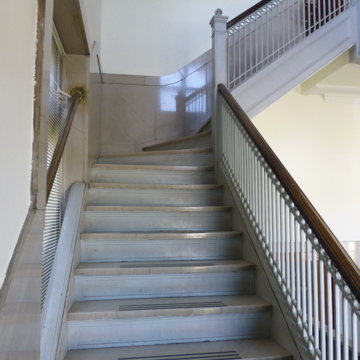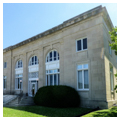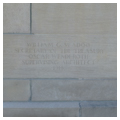You are here
U.S. Post Office and Mine Rescue Station
Republican House Representative Richard Wilson Austin (1857–1919), a former clerk in the Post Office Department in Washington D.C., supported William Howard Taft during the bitter presidential election of 1912. Whether or not it was a reward for his loyalty to the winning candidate, Austin received $80,000 in federal funding to build a post office for his constituents in Jellico, Tennessee. The post office also contained federal offices devoted to mine regulation, safety, and rescue. While this is not typical, Jellico lies in the heart of Tennessee’s coal mining region. The Jellico Coalfield was famous for its high quality bituminous coal. Mining firms owned eighty percent of the land in Campbell and Claiborne counties, providing most of the jobs in this impoverished area of northern Tennessee between 1880 and 1930. Such firms as the Proctor Coal Company employed cheap native laborers, including children, housed them in company towns, and often subjected them to dangerous conditions. To combat strikes, the mining firms indentured desperate European immigrants, and kept laborers in line at gunpoint. Mine disasters near Jellico included the Fraterville Mine explosion of 1902, which killed 216, and the Cross Mountain Mine collapse of 1911, which killed 84. Given this reality, it must have made good civic sense to provide office space for mine oversight in what was the largest federal building in town.
The Beaux-Arts post office is a remarkably refined limestone structure for a small town, and features three two-story-high round-arched windows framed with Tuscan pilasters on the main elevation. Unlike the contiguous street wall of the surrounding blocks, which are lined with brick commercial buildings, the Jellico Post Office is set back from Main Street nearly 30 feet, surrounded by green space, and graced with features normally associated with civic buildings in major cities. The floors of the interior are gray and cream-colored terrazzo. The trim is marble and walnut. Tall bronze lamp posts flank the entrance.
The inscription on the frieze over the entrance reads “Post Office and Mine-Rescue Station.” The first floor of the building served as the Post Office, a function it retains. The second floor was for the Bureau of Mines, an agency founded by the Taft administration in 1910. According to a 1916 description, this floor included “office rooms, a lecture hall, a smoke room, bathrooms, toilets, and locker rooms, all heated by hot air and illuminated by inverted lights.” The lecture hall was fitted with electrical connections to support a film projector, an unusual feature for the period.
The cornerstone of the Jellico Post Office credits its design to Secretary of the Treasury, William Gibbs McAdoo Jr., and Supervising Architect Oscar Wenderoth. Though McAdoo was not an architect, as Secretary of the Treasury under Woodrow Wilson, he was responsible for overseeing the design of all federal buildings. A lawyer by training, McAdoo served the Treasury during the turbulent years of World War I, strengthening the Federal Reserve System, maintaining the country’s finances on the Gold Standard, and protecting American securities from financial panic (he also married President Wilson’s daughter). Oscar Wenderoth and a team of engineers and draftsmen were responsible for the actual post office design. Wenderoth, a native of Philadelphia and the son of the pioneering color photographer Frederick August Wenderoth, worked as a draftsman in various offices, including those of Carrère and Hastings in New York City. He joined the Office of the Supervising Architect in 1897, was appointed Chief Draftsman in 1907, and promoted to head the organization in 1912.
Wenderoth’s appointment came just as the level of work handled by the Supervising Architect increased to remarkable levels. In 1899 the office was responsible for 399 buildings. By 1912, that number had risen to 1,126, about four new projects per day. When McAdoo was appointed acting director, he worked with Wenderoth to standardize designs to make them more affordable to build and maintain. Post offices bearing the names of McAdoo and Wenderoth still stand in towns across the country. While slightly varied in size and degree of ornamentation, these post offices are generally neoclassical in style. They were often a town’s only physical presence of the federal government and a reminder of the success of their congressional representatives in securing so-called “pork” for their constituents. McAdoo likely took a special interest in the post office in Jellico, given that he had studied law at the nearby University of Tennessee and established his practice in Chattanooga. His 1888 house in the historic neighborhood of Fort Wood in Chattanooga still stands.
The building in Jellico that McAdoo supervised and the Wenderoth designed is still in excellent condition, despite modifications dating to 1964 when the structure was fitted with a new HVAC system and acoustical ceiling tiles over the office areas. In 1977 when the U.S. Department of Labor formed the Mine Safety and Health Administration (MSHA), one of its main offices in Tennessee was located in the Jellico Post Office building. That office closed in the mid-1990s when it moved to nearby Jacksboro. But the locked upstairs office door in the Jellico Post Office still bears the MSHA sign.
References
Jones, James Jr. “ Social Control, Social Displacement and Coal Mining in the Cumberland Plateau, 1880-1930.” Every Day in Tennessee History, 1999.
Lee, Antoinette J., Architects to the Nation: The Rise and Decline of the Supervising Architect. New York: Oxford University Press, 2000.
Odom, Ila Ree, “Post Office and Mine Rescue Station,” Campbell County, Tennessee. National Register of Historic Places Inventory–Nomination Form, 1983. National Park Service, U.S. Department of the Interior, Washington, D.C.
Withey, Henry, and Elsie Rathburn Withey. Biographical Dictionary of American Architects (Deceased). Los Angeles: Hennessey and Ingalls, 1970.
“Jellico Mine-Rescue Station.” The Coal Age (Devoted to Coal Mining and Coke Manufacture)IX (Jan. 1 to June 30, 1916): 641-642.
Writing Credits
If SAH Archipedia has been useful to you, please consider supporting it.
SAH Archipedia tells the story of the United States through its buildings, landscapes, and cities. This freely available resource empowers the public with authoritative knowledge that deepens their understanding and appreciation of the built environment. But the Society of Architectural Historians, which created SAH Archipedia with University of Virginia Press, needs your support to maintain the high-caliber research, writing, photography, cartography, editing, design, and programming that make SAH Archipedia a trusted online resource available to all who value the history of place, heritage tourism, and learning.










